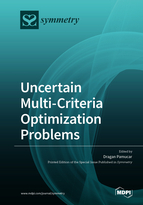Uncertain Multi-Criteria Optimization Problems
A special issue of Symmetry (ISSN 2073-8994). This special issue belongs to the section "Computer".
Deadline for manuscript submissions: closed (31 March 2021) | Viewed by 97573
Special Issue Editor
Interests: multi-criteria decision making problems; computational intelligence; sustainability neuro-fuzzy systems; fuzzy; rough and intuitionistic fuzzy set theory; neutrosophic theory
Special Issues, Collections and Topics in MDPI journals
Special Issue Information
Dear Colleagues,
Most real-world search and optimization problems naturally involve multiple criteria as objectives. Generally, symmetry, asymmetry, and anti-symmetry are basic characteristics of binary relations used when modeling optimization problems. Moreover, the notion of symmetry appeared in many articles about uncertainty theories that are employed in multi-criteria problems. Different solutions may produce trade-offs (conflicting scenarios) among different objectives. A better with respect to one objective may be a compromising one for other objectives. There are various factors that need to be considered to address the problems in multidisciplinary research, which is critical for the overall sustainability of human development and activity. In this regard, in recent decades, decision-making theory has been the subject of intense research activities due to its wide applications in different areas. The decision-making theory approach has become an important means to provide real-time solutions to uncertainty problems. Theories like probability theory, fuzzy set theory, type-2 fuzzy set theory, rough set, and uncertainty theory, available in the existing literature, deal with such uncertainties. Nevertheless, the uncertain multi-criteria characteristics in such problems are not yet to be explored in-depth and there is much left to be achieved in this direction. Hence, different mathematical models of real-life multi-criteria optimization problems can be developed on various uncertain frameworks with special emphasis on optimization problems.
This Special Issue on “Uncertain Multi-Criteria Optimization Problems” aims to incorporate recent developments in the area of applied science. Topics include, but are not limited to, the following:
- Theoretical foundations of MCDM using uncertainty,
- Aggregation operators and application in MCDM
- Multi-criteria in production and logistics
- Risk analysis/modeling, sensitivity/robustness analysis
- Multi-criteria network optimization
- Mathematical programming in MCDM under uncertainty
- New trends in multi-criteria decision-making
Dr. Dragan Pamučar
Guest Editor
Manuscript Submission Information
Manuscripts should be submitted online at www.mdpi.com by registering and logging in to this website. Once you are registered, click here to go to the submission form. Manuscripts can be submitted until the deadline. All submissions that pass pre-check are peer-reviewed. Accepted papers will be published continuously in the journal (as soon as accepted) and will be listed together on the special issue website. Research articles, review articles as well as short communications are invited. For planned papers, a title and short abstract (about 100 words) can be sent to the Editorial Office for announcement on this website.
Submitted manuscripts should not have been published previously, nor be under consideration for publication elsewhere (except conference proceedings papers). All manuscripts are thoroughly refereed through a single-blind peer-review process. A guide for authors and other relevant information for submission of manuscripts is available on the Instructions for Authors page. Symmetry is an international peer-reviewed open access monthly journal published by MDPI.
Please visit the Instructions for Authors page before submitting a manuscript. The Article Processing Charge (APC) for publication in this open access journal is 2400 CHF (Swiss Francs). Submitted papers should be well formatted and use good English. Authors may use MDPI's English editing service prior to publication or during author revisions.
Keywords
- mathematical programming in MCDM
- fuzzy set theory
- neutrosophic theory
- rough set theory
- grey theory
- engineering applications






